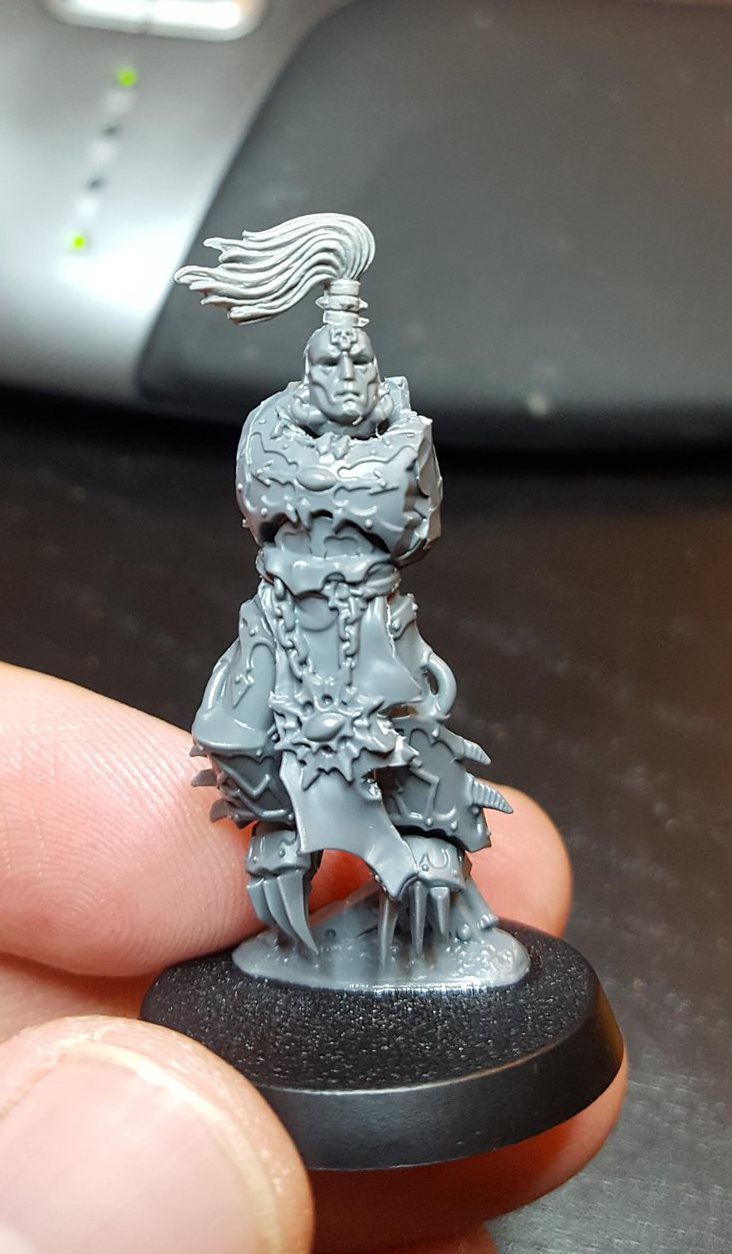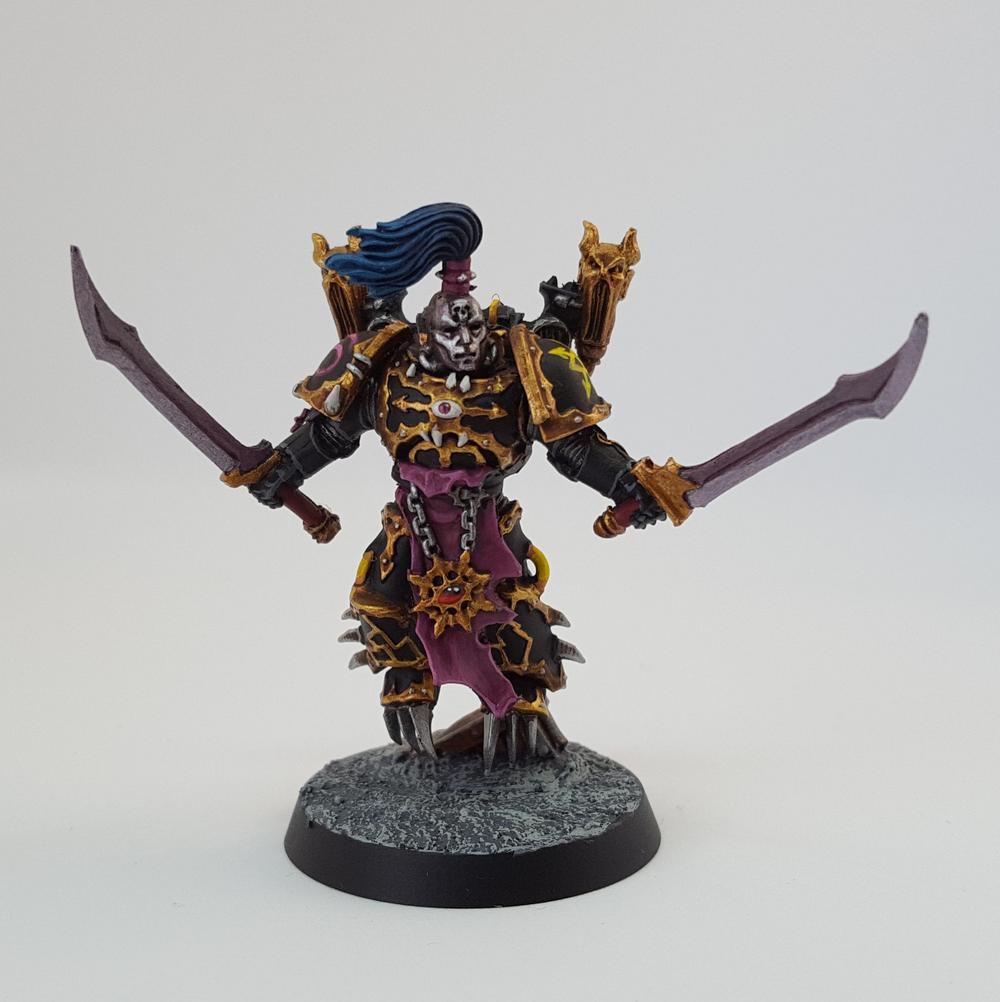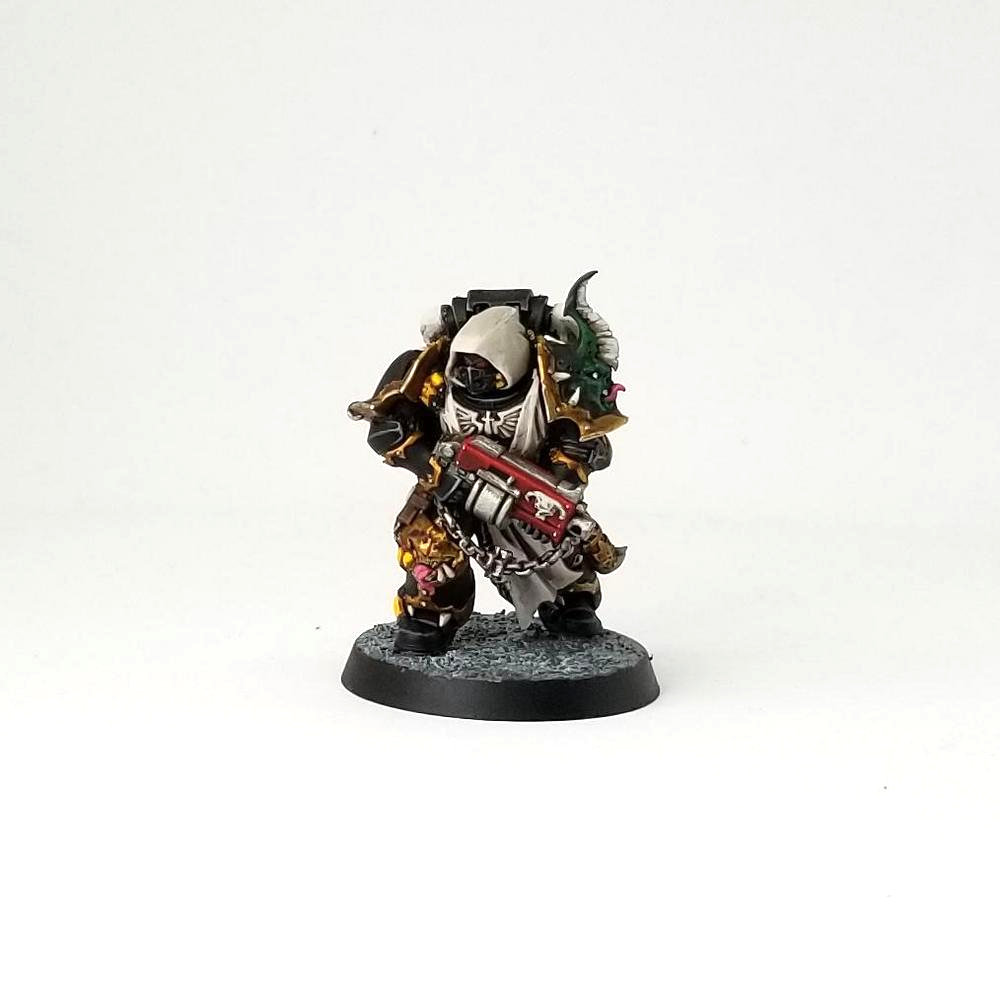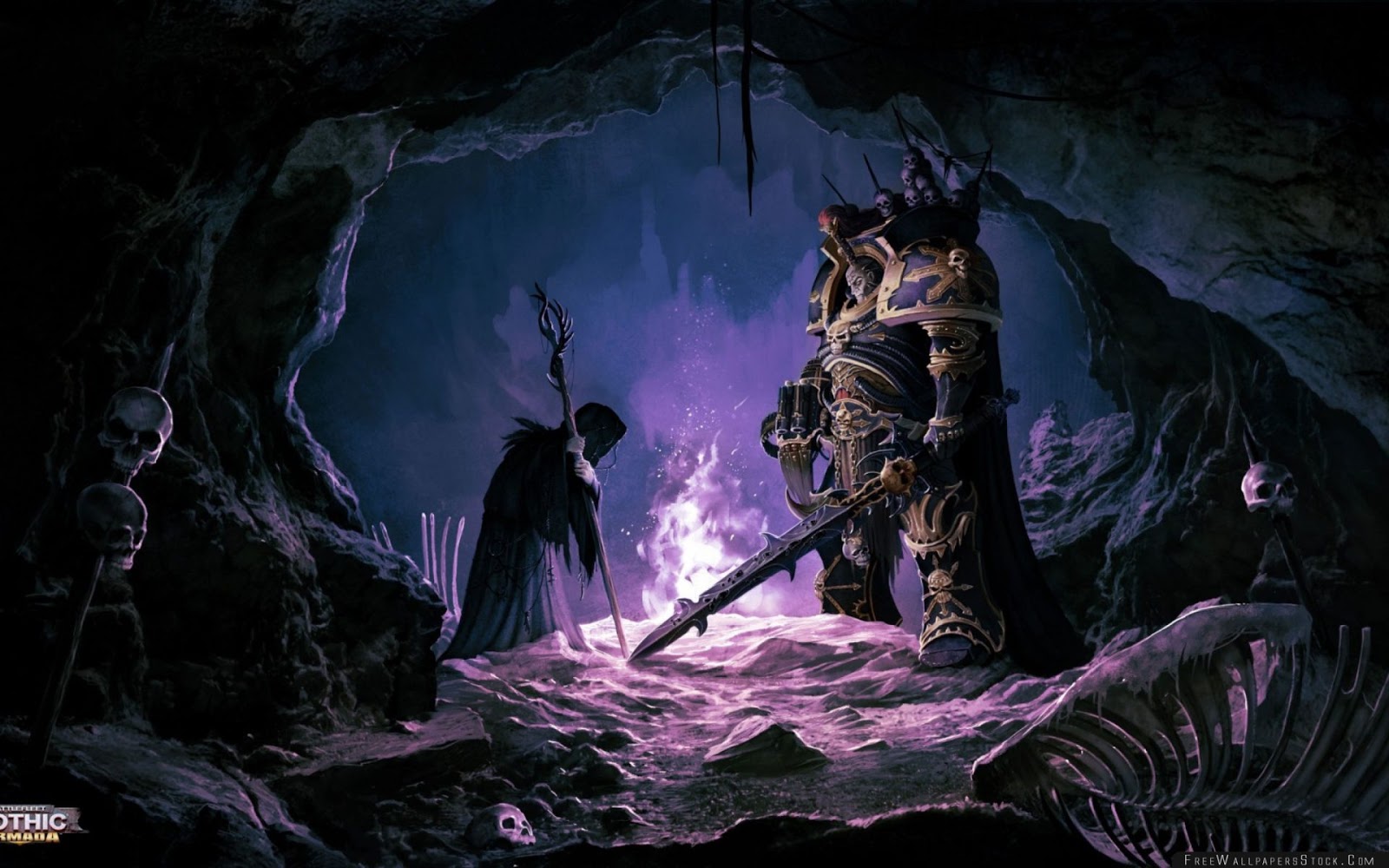In our Hobby Heresy series, we encourage thinking outside the box (literally) when putting models together. They aim to make hobbyists comfortable growing beyond imitating the models they see in their Codexes, and serve as a source of inspiration for anyone wanting to make an army that’s uniquely their own. This week, TheChirurgeon is talking about modeling and painting characters from novels and other media for the tabletop.
While the quality may vary book-to-book and game-to-game, the best Black Library novels and Warhammer licensed games do more than just tell a great story. They also inspire us, and get us thinking about the characters and places we’ve experienced and how we can bring them to life on the tabletop. The Warhammer hobby is perfectly suited to taking the images in our mind’s eye and translating them into real life by mashing together different kits and creating our own bits. In today’s Narrative Forge, I’m going to talk about bringing these models to life, with tips and tricks for how you can do conversions of your own, and how you can draw inspiration from this media to do more than just convert specific characters.
Making Friends
As a longtime Chaos fan, it should be no surprise to find that I absolutely loved Aaron Dembski-Bowden’s Black Legion series, which covers the early days of the legion’s formation and Abaddon’s ascension to Warmaster of Chaos. The characters are well-written and I love the interplay between them, particularly the trio at the core of the first book, The Talon of Horus. Iskandur Khayon, Lheorvine Ukris, and Telemachon Lyras are really cool not-quite-friends and sometimes enemies who are cool enough that I wanted to field them in my Black Legion army, regardless of whether they’ve survived to “present day” in the 40k universe.
One of the best things about the 40k novels is that they can be fantastic inspiration for modeling, particularly if you’re looking for inspiration on squad leaders and kill teams. One of the coolest parts of the novels featuring Abaddon has been the introduction of the Ezekarion, a group of 13 figures – not all of whom are chaos space marines – who advise the Warmaster and act as his “elite council” in matters relating to The Long War.
As they’ve been introduced, the Ezekarion includes 13 characters:
- Falkus Kibre, a Justaerin Terminator captain who fought under Horus and Abaddon during the Heresy, and becomes possessed during the events of Talon of Horus.
- Iskandar Khayon, a former Thousand Sons Sorcerer who acts as Abaddon’s assassin and may be the strongest psyker in the Thousand Sons after Magnus and Ahriman
- Lheorvine Ukris, also called Firefist, a former World Eater
- Telemachon Lyras, a Champion of Slaanesh and a former member of the Emperor’s Children
- Sargon Eregesh, a former Word Bearer, psyker and daemonologist whose vocal chords were cut so he talks through nearby corpses
- Ashur-Kai, a seer and former Thousand Sons marine. He’s an albino and a longtime friend of Khayon’s
- Ceraxia, a Heretek tech priestess from the Dark Mechanicum who runs a daemon forge world in the Eye of Terror
- Valicar Hyne, a former Iron Warrior who commands the Black Legion’s fleets
- Vortigern, a Fallen Angel and “the most serious person Khayon had ever met”
- Amurael Enka, a Black Legion Chaos Dreadnought. He used to be an Apothecary until a Khorne Daemon murdered him
- Ilyaster Faylech, a former Death Guard Apothecary who followed the Sorcerer Lord Thagus Daravek
- Moriana, a seer and prophetess who sought out Abaddon. She’s a former Inquistior and a member of the Horusian sect.
If you’re building a Black Legion army and looking for inspiration, the Ezekarion not only gives you 13 characters to model directly, it also provides some incredible inspiration for how to think about modeling your own army. We’ll come back to the inspiration piece for other models in a moment. For now, I’m going to talk about those characters and how to bring them to life, and how I did that while building my own Ezekarion. There are two basic ways we can create a model of a character:
- Literal Translation – We might go for a literal translation, looking for ways to replicate the specific visuals and descriptions of the character in the media. These types of conversions will be most common when we’re building a model of something that has very detailed descriptions, such as a primary protagonist or antagonist, or a character which has popular artwork depicting them. While we can still do something more evocative with these characters, often the descriptions and images that are already out there will make it easier for other fans to identify what we’re going for if we hew closer to the existing depictions.
- Evocative – We may try for something less literal and more evocative of the character, emphasizing certain key details of their personality and then filling in the rest with our own details. In these cases we may aim for some broad sketches from the character descriptions and then focus more on posing or character traits that we can communicate visually and not worry about matching things up 100%. This is the path we’ll likely have to take for minor or secondary characters whose descriptions are much less detailed anyways.
Most of the time, we’ll be doing a mix of both, because there will be areas where our existing models and kits don’t allow us the luxury of a perfect literal translation and so our goal should be to make something where another fan or someone familiar with the work would be able to pick up pretty quickly on what we were going for. When you’re starting work on one of these conversions, they key is to start by planning out how you’re going to build a specific model. What are the key things about them you need to capture on a model? What weapons and armor do they need to have? What kind of pose do you want for them? The way I usually do this is by going back and earmarking specific passages and details about a character that describe their appearance and armament. I’ll also do a search online at this point for any art of the character that’s relevant. When I started on my Ezekarion, I decided to start with the key protagonists of The Talon of Horus: Khayon, Lheor, and Telemachon. There’s art for each of these, and I wanted to do a pretty literal translation of the art:
Khayon
Khayon is a former Thousand Sons sorcerer and the primary protagonist of the Black Legion series. His key traits are that he’s a potent psyker, he’s one of the Thousand Sons (and so would need armor that marks him as such), and in Black Legion he carries a two-handed axe taken from a Space Wolves champion during the Burning of Prospero. While he loses the Axe in the first book and trades it in for a sword in Black Legion, I knew that I wanted to make Khayon with the axe. In part because force axes look cooler and in part because the axe is just a much more recognizable character weapon, especially since it’s visibly a Space Wolves artifact. I sourced Khayon’s bits primarily from the Thousand Sons Exalted Sorcerer plastic kit (this gave me a robed bottom half), but used a head from the Rubric Marines kit because I felt it was a better match for the way the helmet in the art looked. It’s not a perfect match, but I liked this helmet more than the other options. I’ve seen a lot of conversions for Khayon that use Ahriman as a base and while I think those look very dynamic, I chose not to go that route in order to make sure that Khayon wouldn’t look off next to Ahriman if I wanted to run them together. Finally, I did some bits research and found that the only two-handed Space Wolves axes were in the Wulfen kit, so I picked up one of those.
Finally when I painted him up, I chose to put him in the blacks of the Black Legion, so I could tie him to my army visually. That’s also why he uses white cloth bits – he’s matched to other Tzeentch-marked sorcerers I’ve painted so he still appears to be cohesively part of the army. I’m very happy with the end result, which is recognizably Khayon in a lot of ways despite not being a perfect recreation:
Telemachon
Telemachon is a former member of the Emperor’s Children and a total bastard. I liked him immediately. When I was working on him I knew I’d need to replicate his mask, the most recognizable element of his description, and I needed to make sure he was armed with two swords. Unlike with Khayon, there are a lot more bits that match Telemachon’s art to work with:
The big things I needed to match here besides the mask were the Noise Marine backpack, which I could reliably source from one of the old Finecast kits, the taloned feet, which can be found on Raptors, and the twin swords, which show up on Horus Heresy Emperor’s Children Palantine Blades models that Forgeworld puts out. The biggest challenge with Telemachon and Lheorvine was that, size-wise, I wanted them to match the current range of Chaos Marines, but at the time I made them – mid-2018 – new plastic Chaos Space Marines hadn’t been released. All we had were the plastic Chosen from the Dark Vengeance kit. These are solid models, but difficult to work with as they’re monopose and fit together in weird ways. I built Telemachon by cutting off the chest and tabard of a Dark Vengeance Chosen with bolter, cutting out the legs behind the tabard, and replacing them with Raptor legs. For the helmet, I used a Blood Angels death mask and added a top knot from a plastic Chaos Space Marines champion, which gives him a very similar look.
I’m pretty proud of this guy, who I think is unmistakably Telemachon. Like with Khayon, I chose to paint him in Black Legion colors, while using pink/purple accents to help make visually clear his allegiance to Slaanesh and former life in the II Legion.
Lheor
The final of the three Black Legion amigos is Lheor, the former World Eater known as “Firefist.” He’s called that because he was a Devastator in the World Eaters, then his plasma cannon blew up and took both of his hands with it. His art is fantastic.
Doing Lheor justice means arming him with his signature heavy bolter, plus nailing his wicked Khornate headgear. He wears a distinctive chestplate in the books, retaining a silver skull aquila that I wanted to make sure I used as well, and I wanted to copy his bare-armed look while making it more obvious that his hands were replaced by robotic ones. As with Telemachon, I had to resort to cutting up a Dark Vengeance Chosen to make Lheor, using the walking legs of the Chosen with a power axe and cutting off his chest piece. In order to do Lheor’s chest, I used a loyalist Space Marine torso and filled it with about 2mm of green stuff to widen it to match the larger proportions of Chaos chosen. The heavy bolter is a standard Chaos Space Marine heavy bolter, though I wish I’d had one of the newer, more visually interesting ones to work with. Ah well. His arms are Catachan arms I got from Buffalochicken and attached to Space Marine hands, then I wrapped the wrists with jeweler’s chain to replicate the chains look. Finally the head is a Night Lords head from the Forge World Horus Heresy Upgrade kit with an Age of Sigmar headdress. Again, I painted him black to match his brothers. I’m also incredibly happy with how this guy turned out and I think it’s obvious what I’m going for.
More Ezekarion Members
Since I did these guys, I’ve worked on a few more of the minor Ezekarion members. The descriptions of these guys are harder to come by, so I tend to work off what I can make visually interesting about them. Even people who’ve read the books aren’t as likely to recognize them, so it’s more about evoking a specific feel with these guys.
Vortigern
Vortigern’s a former Dark Angel and another guy I made out of a Dark Vengeance Chosen. Here the challenge was hollowing out the model’s chest to replace it with a Dark Angels robed chest and a robed head. Then I just swapped out the backpack. The end result is a model that’s unmistakably a member of the Fallen, and that’s about all I need to achieve what I’m going for here. This is also where I wanted to make more “regular Marine” style models that would work well in a Kill Team so I didn’t just have a bunch of Chaos Lords running around.
Illyaster
Illyaster is a former Death Guard Apothecary and I started planning him right after the Death Guard codex came out, so he was by far the easiest model to convert. Just swap out a shoulder pad on the Plague Surgeon and bam! – done.
Moriana
The most recent Ezekarion conversion and another easy one. I needed to convey “old witch” to match the art that’s been done on her.
For Moriana I used a Warhammer Fantasy plastic Necromancer and just swapped out the head for the head of a Dark Eldar Wych whose ears I shaved down. This causes it to read as slightly more female, I think. The only thing I don’t like about this model is how dark it is, which makes it hard to photograph. She’s also odd in that she doesn’t really have a purpose in my Black Legion army. I guess I can run her as a Sorcerer, but making her was really more about having a model to put next to Abaddon in my display case.
That’s what I have so far. My plan is to eventually do the entire Ezekarion, so I’ve been sourcing more bits with a plan to tackle Falkus Kibre next, which should be a lot of fun now that there are some better possessed bits out there to work from. I’ve also started sourcing bits for Amurael Enka, and Khayon’s two personal Companions, the Dark Eldar Nefertari and his second familiar, Nagual.
An Alternative Take
One of the great things about building characters from other media is that there’s always more than one way to approach modeling them. I asked fellow Goonhammer contributor Dan “FromTheShire” Gates to share the WIP of the Khayon he’s been working on. Dan’s chosen to go the Ahriman route, and he’s modeled Gyre, Khayon’s original familiar. In Dan’s words:
Here’s my kitbashed Iskandar Khayon, inspired by the fantastic Black Legion novels by ADB. In a desperate but likely doomed effort to stave off doing a full army due to his sheer awesomeness, I decided to start a Thousand Sons Kill Team force with him as my sorcerer and his faithful tutelary Gyre (counts as Tzaangor). Since GW can’t trick me with their cheap buy-in format, I used the new Ahriman kit as a base. After trimming most of the staff off for most of a Wulfen axe, and grinding out the neck to accept an Exalted Sorcerer head, I added the sorcerer’s backpack and shoulder pad, as well as a 3d-printed Legion marking from Pop goes the monkey.

There are a bunch of different ways to approach this but I think it’s telling that we both chose to use the axe over the sword — it just makes it much more visually clear that you’re looking at Khayon, and while I think sword Khayons would be interesting to see, I don’t know if I’d pick up on that right away. It’s definitely something to consider when you build these–what are most basic elements of the character you need to get down for someone to know who the model is representing?
Drawing Inspiration
Now let’s talk about taking a less literal approach to adding character to your army using the content from books and other media. It’s not just about re-creating characters; Warhammer fiction can provide the backstory or inspiration for individual models or an entire faction. As I’ve built out my Black Legion, I’ve focused on more than just building the Ezekarion and its members – the Legion is composed of many different subfactions and warbands, each with their own personalities. The Ezekarion is a great example of this in a way that goes beyond just its characters — the Ezekarion and really, the entire Black Legion, incorporate members of every facet of Chaos, with warriors of nearly every legion, devotees to every god and the undivided powers, the Dark Mechanicum, the Fallen, and a corrupted Inquisitor. If you’re working on your own Black Legion force and you want to add character to your army and personalize the models in your army (or just your kill team), this is a great place to start. As you work on a model, ask yourself:
- What legion or chapter is this model originally from? How did this model end up in the Black Legion?
- How can I model that? What details can I give them to represent their original heritage?
The goal here is to think about how you can infuse each model with its own character and backstory, which will ultimately make the whole army stand out. In addition to the novels, I like to trawl through older codexes and books for pieces of fluff or inspiration on heraldry. As I built my Black Legion, something I focused on was covering the special warbands within the legion, such as the Hounds of Abaddon, the Sons of the Cyclops, and Bringers of Torment. These groups represent large warbands within the Black Legion, each devoted to a specific Chaos God and with their own paint schemes and visual motifs. Using this motif helps tie the army together visually when i want to do something like a Khorne-heavy army, and also gives the group a lot of character, making it clear that they have more going on.
Deathwatch are another fantastic army for this kind of work, where you can build a chapter backstory for each model, and really build out tiny little character stories, or build from existing fluff. Take characters you’ve read about and re-imagine them as temporary members of the Deathwatch. Or copy the general concepts and armament to capture a similar feel without naming the exact character.
Likewise, if you’re working from a different novel, such as Spear of the Emperor, this is where you can start thinking about the characters in the book and how their descriptions can be attributed to the Chapter at large. What about their heraldry can you use? What are the most obvious references they’re working from? Are they using Gaelic runes and imagery? What other real-world sources can you draw from when working on these? One of my favorite examples of doing this are Seyni N’Diaye’s Carcharodons, an army which draws heavily on Maori and Polynesian imagery to decorate their armor. In addition to acting as inspiration for cool visual designs, locking into this aesthetic helps inform other choices he’ll make when modeling the army, such as using large fishooks, serrated blades, shark jaws, and tooth necklaces. It really draws the army together visually and gives them a flair that sets them apart from other armies you come across. The best way to start this kind of work is to do some research. Think about the visual elements you want to incorporate and go online, look into the elements you want to incorporate and find out where they came from and how you can draw from real-world inspiration and other art sources. As you do this, just remember to be respectful of the cultures and sources you’re drawing from.
Go Create
That wraps up another Narrative Forge. I hope you found my plotting helpful for planning your own characters and armies. If you have your own book characters you’d like to share with us, please do! Either post it in the comments section below or email it to us at contact@goonhammer.com. We’d love to see what you’re working on and feature it in a future article. And keep up that hobby progress.













